United States
Released 1979 for Apple II
Date Ended: 17 November 2015
Final Rating: 13
A few months ago, a commenter named Keith (AKA, the Golden Age Arcade Historian) did one of those things that I both really want you to do and kind-of don't want you to do: he sent me a list of a bunch of RPGs that aren't on MobyGames or Wikipedia, the two major lists that I used to compose my master game list. When you have a "to do" list of 2,000 items, the last thing you want is for someone to give you 20 more tasks. On the other hand, when you created the list specifically because you want to do those things, you could regard 20 extra items as like a bonus. I go back and forth.
Moreover, it sounds like Super Dungeon might not even be the first. In the same catalog, the game is described as "a SUPER version of the popular Dungeons and Dragons game." I don't know if they're literally referring to the tabletop D&D or some computer predecessor.
 |
| The description of a warrior in Super Dungeon (1979)... |
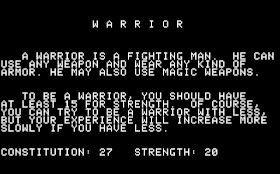 |
| ...and in Dragon Fire (1981). |
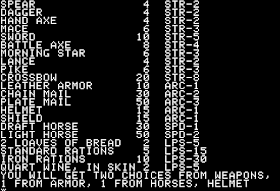 |
| Purchasing initial equipment. |
After inventory acquisition, you enter a randomly-generated, lo-res dungeon in which your character is indicated by a brown square. The style of the dungeon, if not the mechanics of exploring it, seems to have been inspired by Programma's previous Dragon Maze (1978). (Dragon Maze is a non-RPG, but it inspired a couple of RPGs, including this one, Dungeon Campaign, and Beneath Apple Manor.) You move via (U)p, (D)own, (L)eft, and (R)ight commands. Secret doors are blue, locked doors white, and regular doors gray [ed: I guess they're 'magenta' or something. My colorblindness strikes again]. Different character types take different injury levels when trying to pass through locked or secret doors.
 |
| I fight a chimera in hopes to win that bit of armor. |
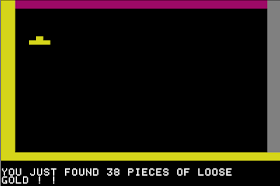 |
| Reward with no risk. |
And occasionally, you find a special encounter, such as this room full of coffins that can contain treasure, skeletons, or magic gasses that either increase or decrease attributes.
 |
| That's not cool. |
There is some strategy in how you explore. You lose one life point for every step you take, so you don't want to linger too long before heading for the level's exit. But if you hit the exit too soon, you won't have amassed enough experience to handle the more difficult creatures on the next level (or even replenished what you lost on this level). You need to try to find the right balance and make sure you can advance, if only slightly, in constitution and life points. Fortunately, you can retreat to earlier levels if you need to. You can also save and reload the game at any point.
 |
| The game's "main quest." |
If you're cautious, the game isn't too hard. I managed to make it to Level 5 in about 2 hours of playing, without having to reload. Rather than press my luck, I took advantage of a portal and escaped.
 |
| I'm not sure what the "gold deposited" bit is about. I never saw anything that would allow me to "deposit" gold. |
A couple of features were lost between the two games. Dragon Fire doesn't have secret or barred doors, removing some of the navigation challenge and decreasing the utility of a couple of character classes. Super Dungeon has monsters that only wizards or warriors with magic weapons can defeat; these are gone in Dragon Fire, again reducing the usefulness of the wizard class. I don't remember special encounters like the coffins in Dragon Fire. Finally, Super Dungeon has an extensive in-game manual, moved to a paper manual for Dragon Fire, likely to accommodate all of the detailed room descriptions in the latter game.
 |
| The long in-game manual describes all of its elements in detail. |
Super Dungeon certainly would have tickled the imagination in 1979, but it doesn't do well on my GIMLET today, earning only 13 points. (Dragon Fire got 18, since it had a back story, quest, and the detailed dungeon descriptions.) It does best (3) in "character creation and development." I like that the choice of class really matters, and I like the way you can spend experience directly on attributes.
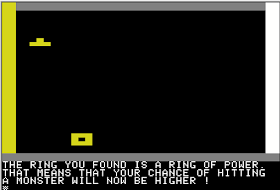 |
| Despite the primitiveness of the game, this was always a bit of a thrill. |
Super Dungeon is a reasonably good representative of the era. If you look at the 1978 and 1979 commercial RPGs, the list is full of titles--Dungeon Campaign, DUNGEON, Dungeon of Death, Dunjonquest-that feature different graphics and mechanics but the same basic approach to gameplay: roll a basic character and explore a random dungeon looking for treasure, enhancing the experience with your own imagination, with the only overt goal to get out of the dungeon richer than when you went in. (Beneath Apple Manor, The Wizard's Castle, and Wilderness Campaign are slightly different in featuring main quests, but none of them are full RPGs.) It wasn't until the success of Akalabeth, first published in 1979 but not widely released until 1980, that an ending started to become the norm in CRPGs.
Super Dungeon seems to be Rodney Nelsen's first game. I'm not sure what led him to enhance and republish it as Dragon Fire (1981), but Programma International was foundering by then, so perhaps the rights had reverted to Nelsen. I'm not sure whether he had anything to do with Level 10's Alkemstone (1981), a maze-running adventure that delivered clues as to the location of a real-world cache and offered a cash prize of $5,000 to the person who could find it. (As far as anyone knows, it's still out there.) He definitely did participate in Kaves of Karkhan (1981), an in-name sequel to Dragon Fire that is best described as a first-person adventure game rather than an RPG. In 2013, I got half a posting written on it before I realized it met none of my criteria. Nelsen also published a first-person shooter called Tharolian Tunnels through Datamost in 1982, and he appears on the design team of several Carmen Sandiego titles in the 1990s. After that, he disappears into the ether, obscured in Internet searches by many others of the same name. I tried finding him to ask about Super Dungeon and Dragon Fire but have not had any luck.
I'm still going through the rest of Keith's list and adding the ones I agree are RPGs to my master list. For the ones that precede 1984, I'll play them soon (I don't want to have three active lists) but not next. Martian Dreams is on hold until next week for reasons I'll explain later, so you'll probably see me slide into Shadow Keep next.


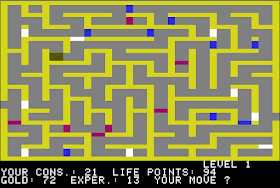
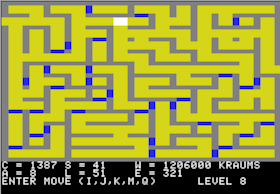


Just have to say, your thorough research into the history of these games is as impressive as reading your playthroughs. Fantastic work on this blog, really.
ReplyDeleteRef "stirges [sic]", that's the way they spelled it in the original D&D manuals, and the typo has stuck ever since. Since the stirge isn't exactly a vampire, it could be argued that it's actually an original creature, in which case giving it a new name is fine. Anyway, it isn't this game's fault - D&D did it first. :-)
ReplyDeleteI remember this discussion coming up recently, but I remembered it wrong. I thought the story was that D&D had correctly spelled it as "strige" but knock-offs had misspelled it. Thanks for the clarification!
DeleteHuh. I've done a lot of reading about early D&D, and had never heard of the 'strige'. My fault for focusing too much on the game and not enough on classical mythology.
DeleteI agree that stirge has been in use so long in the D & D world that it is the standard spelling. You would get a lot of funny looks if you told players they found a grex strigarum.
DeleteNow we have several of these thingies.
DeleteStriga (strzyga) - An undead female vampire who feasts on pregnant women.
Strige (strix) - A vampiric bird.
Stirge (D&D) - A huge mosquito.
Unless I'm reading the picture of secret doors wrong, their colors are blue, white, and maroon, with yellow walls, rather than the reported blue, yellow, and grey.
ReplyDeleteYou and Fred can slug it out as to whether the regular ones are maroon or red. I did mean to say "white" for the locked doors.
Delete"Secret doors are blue, locked doors yellow, and regular doors gray." The doors in your screenshot are blue, white, and red. Is this your color-blindness at work, or did you just goof?
ReplyDeleteA combination of both, I guess. I meant to say "white" for the locked doors. I guess the ones that I'm perceiving as "gray" or actually red. Really? That's red?
DeleteDefinitely red.
DeleteThe corridors are all gray though. How do they look like to you, Chet?
DeleteI wouldn't call them "red". Magenta is more appropriate I think.
DeleteThat's not red, nor brown. As Oleg said, it's more appropriate to call that colour magenta (or reddish purple). Through the magic of HTML5 you can pick the colour out of the picture and it's hexcode is #A70068; it contains 0 green in RGB, which brown always contains (brown is mixture of red and green in RGB). Also the original Apple II couldn't do red anyway :)
DeleteIndependently of the exact colours, having "secret doors" all highlighted on the dungeon map from the start doesn't really make them very "secret"... .
DeleteI understand the only difference to "locked" doors is how different character types are injured or not when going through them as mentioned above and detailed on Nathan Mahney's blog (https://crpgadventures.blogspot.com/2020/03/game-38-super-dungeon-1979.html). For that purpose, a different term would have worked as well (or even better). But of course it's easy to nitpick in hindsight and creating a commercial CRPG pre 1980 is still a feat.
Good job on the comparing and contrasting. I still like Dragon Fire better due to the room descriptions.
ReplyDeleteI can't recall if I added this before or not Sylvern Castle was an Apple II game purchased by SoftDisk 1988 but unpublished until 1999. It has had some updates so I'm not sure how you classify this. It definitely isn't mentioned on Moby Games and there is a mention on Wikipedia but not in any of the lists of RPGs.
ReplyDeleteIt is effectively a Wizardry clone. In fact the author wrote it in BASIC because IIRC the Wizardy manual states that Wizardry couldn't have been written in BASIC. Details here: http://finkjsc.a2hq.com/silverncastle/
I'm more than happy to give you a hand getting it running in an Apple II emulator. I won't say "it's easy" because that's in my experience a phrase that people with hundreds of hours of experience say to neophytes which does nothing but promote ire. It's also ranks #1 on my list of "least helpful things people can say while still imagining they are helping".
That sounds like it deserves inclusion in the Addict's 1988 roster. I appreciate it when programmers hear something is impossible and then make a point of doing that very thing!
DeleteAgreed, a similar train of thought is when a developer sees a program and says "That would be so much better if it could only..." and goes ahead and does this. IMHO this is responsible for the incremental nature of a lot of game development history.
DeleteA few months back I was watching a video of Kings Quest on the Apple II and noticed how horrifically slow it did things like draw lines or fill regions (or even clear the screen) and decided I should write some routines that were considerably faster.
So I did. :-)
I've been playing this for a few days and I can confirm that it has an ending of sorts: if you make it to level 20, there's a black portal square in the bottom left corner, and when you step on it it tells you that you made it to the bottom of the dungeon. Then it returns you to the surface, like a regular portal. So it's 20 levels of dungeon, and that's it.
ReplyDelete"Moreover, it sounds like Super Dungeon might not even be the first. In the same catalog, the game is described as "a SUPER version of the popular Dungeons and Dragons game." I don't know if they're literally referring to the tabletop D&D or some computer predecessor."
ReplyDeleteThey're referring to TSR's tabletop game Dungeon! from 1975, in turn based in D&D.
All the game names im the catalog are followed by "!", but this one is followed by "!!", so the real game name in the catalog is Super Dungeon!
There was a prior computerized version of Dungeon! named Dungeon Adventure in 1978 by Farrel Enterprises for the TRS-80.
The mechanics are simpler, with no character development, but the essence is the same: you choose a character class and explore a random dungeon for gold.
Maybe the author made Dragon Fire to avoid legal conflicts with TSR.
"I'm not sure what the "gold deposited" bit is about. I never saw anything that would allow me to "deposit" gold."
ReplyDeleteLooking at the source code, I discovered you can deposit all your gold in the portal in level 15 (the portals are in levels 5, 10, 15 and 20). If you enter the portal square and say you don't want to leave, you deposit all your gold, so the thief can't steal it from you.